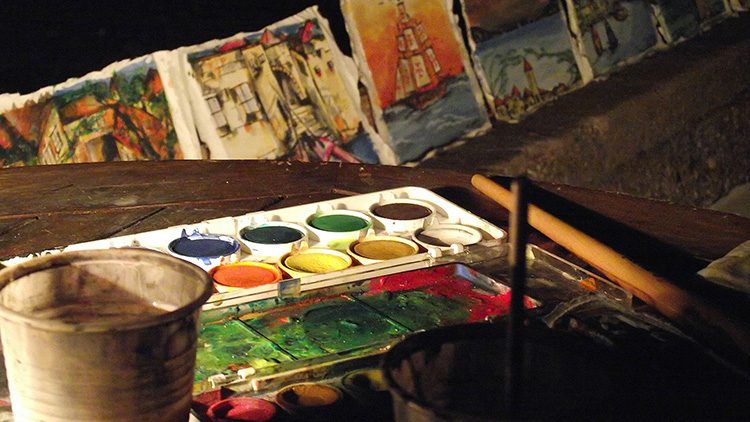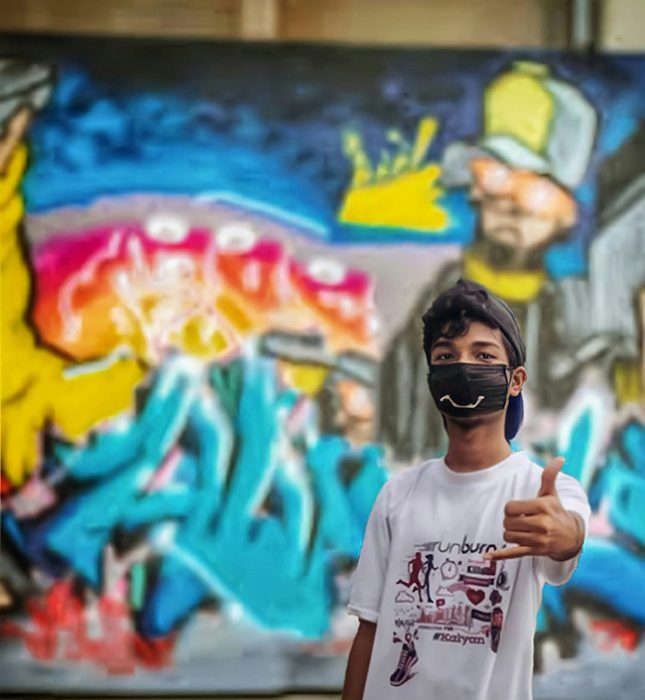Your artist studio is where the magic happens, and having the opportunity to host collectors, curators, gallerists, and art consultants gives you the chance to invite them into an intimate world. But did you know that the best, most successful studio visits are thoughtfully created well before they actually take place?
From making sure that your space is well-organized and clean before visitors arrive to having an ample supply of beverages and snacks on hand, there are some simple rules to follow to ensure that you’re providing a comfortable environment that will eliminate distractions and keep the focus on your work.
So after you’ve prepared your artist studio, considered your talking points, and catered the experience to the individual that’s coming, what else can you do to prepare to welcome someone into your space? We have a few pointers to ensure that your next studio visit goes according to plan—and makes a great impression.
Not every artist studio visit is alike
Collectors, art consultants, curators, and gallerists are constantly searching for artwork online, but going to an artist studio allows for a much more profound and intimate connection to you and your work. In fact, in-person studio visits can be the key to forging relationships that can enhance your career and give you greater visibility.
So what’s the ultimate purpose of an in-person visit? The answer is ultimately a reflection of who you’ve invited into your space. Your first priority is to have a clear intention about why you’ve invited a specific person to see your work and identify what, exactly, you hope to get out of your time together.
When you invite someone into your artist studio, the main objective is to serve your work. Making sweeping goals of “I want a show” or “I want to sell my art” are not specific enough, and you’ll need to think more broadly. Another great tip? A studio visit is not a critique, unless you’ve made that intention clear before your guests have arrived. Critiques are, ultimately, a very specific kind of conversation, and not one that everyone feels comfortable with.
Know your audience
Have you identified someone that you’d like to invite into your space? Then the next step is to consider whether they have a thoughtful point of view that might help you develop your work.
Do they have a unique approach to how they look at art? Do they possess specific knowledge in certain areas that could help you approach your work in a new way? A thoughtful guest can help you identify connections between your art and the work they support.
Stephanie Theodore, principal of Theodore Art in New York, rarely does an artist studio visit. However, the rules change when “We seem to have a rapport in person, and I like what I’ve seen of their work online or elsewhere” or “ They’ve come to my gallery and seen what I show. We’ve talked in person and I’m curious about them and their work.”
And regardless of who initiated the visit, it’s paramount that you do your research. Are you planning to welcome a gallerist? You need to visit their gallery. Is a curator stopping by? Then you’ve hopefully seen their exhibitions in person, or at least familiarized yourself with their projects and proclivities.
If you’ve invited an art consultant or collect, do a quick internet search to see if there’s any information about the work they’re interested in. Is it someone that’s new to collecting? People less familiar with the art world may feel anxious and not know what to expect when visiting an artist studio, which means the onus is on you to be sure that they feel welcome.
Make sure your artist studio is tidy yet functional
If someone has contacted you about visiting your space, ask if there’s a particular body of work or piece that they’re interested in viewing. At the end of the day, the purpose of an artist studio visit is to share work that tells a compelling story about you as a creative and the details behind your process.
When deciding which works to show, there are numerous ways that you might make your selections. Ultimately, you’ll want to be selective and put the focus on finished pieces rather than work in progress. Even if you’re sharing pieces from different bodies of work, make selections that tell the most compelling story about your artistic evolution and process. You might even create a space that’s dedicated to showing your visitors a specific technique or something that inspired the work.
You’ll also want to organize your artist studio in a way that is flexible and malleable; allowing you to easily pull out other pieces that your guest might want to see. If an artwork is too difficult to access, you can always show it on a computer. But as a general rule of thumb, unless the work is digital, video, or otherwise computer-based, you don’t want to spend too much time in front of the screen.
If you do not have access to a computer, resist the temptation to try and show work on your phone. As an alternative, you can always follow up afterwards with images and/or videos.

You don’t need to neglect character, but your artist studio should be in tip top shape.
Pay attention to the basics
Before your guests arrive, make sure your artist studio and other facilities like the bathroom are clean and organized. You want your visitors to focus on your work, and not the mess that’s collected in the corner. Rehearse what you want to say about your work and get clear on your pricing, just in case the conversation heads in that direction.
Finally, take the time to email and confirm the day before. Make sure there’s an easy way to access the building and locate your space, and be sure to have water and snacks on hand for when they arrive.
It’s time to shine!
Take a deep breath, say your affirmations, and get ready to talk about your work. When someone visits your artist studio, they’re there for show and tell. Be prepared to talk about your process, sources of inspiration, and what inspires or influences your work. It leaves a bad impression when an artist is unable to talk about their work, and the phrase “the work speaks for itself” will lead to a dead end.
You’ll also want to give some thought to what you consider more contemporary influences. Art historical references, while fascinating, do not tell the bigger story, and most visitors—especially decision makers—want to understand how you’re actively engaged in the current art scene and participating in the larger conversation.
Finally, while we know it can be difficult to speak about one’s self, make sure that you’re not overly self-deprecating. If you’re not feeling confident about the art that you intend to show, it’s actually better to postpone the visit than to welcome someone into your space. In short, don’t expect someone’s visit to be about boosting your ego.
Remember to listen
When someone visits your artist studio, be sure to give them space, don’t hover, and allow them ample time to look at the work. Listen to what they have to say and give their comments and questions consideration and respond in a way that facilitates a thoughtful exchange.
Most seasoned arts professionals are interested in having an honest conversation about the art, which means hearing about your thoughts and feelings while feeling safe and able to contribute new ideas themselves. You may not get a show or sell a piece, but an engaging dialogue is everything: let your visitors open your eyes and allow you to learn something new about yourself.
It’s all about the long game
Only rarely does a gallerist or collector visit an artist studio with the intention of placing work in a specific show. Instead, they like to visit because they’re curious to learn more about the work and the person behind it. A successful visit is just one step towards building a relationship, and it should never feel transactional. One art writer shares, “I may not write about the artist immediately, but I keep them in mind for future articles and might feature their next show [in my work]”.
The reason why critics, gallerists, curators, and collectors visit your space is because they want to see your work, but they’re also ultimately curious to see if you both have a connection. Are you someone that they would enjoy working with? Are you adept at articulating why you’re making the work that you make? Are you an artist that they’d want to have additional conversations with in the coming months, or even years? The harsh reality is that there’s no shortage of talent to choose from, so if you’re difficult to work with, unprofessional, or inarticulate, you’re very likely to be passed over.

Being a good person is also good business.
Stay positive
Despite your best efforts and careful preparation, sometimes studio guests and artists just don’t “click”. Try your best to avoid taking it personally and maintain a positive mindset. Studio visits can sometimes be awkward, so if you’re not feeling a strong connection or vibe, get through it professionally and move on.
Have fun
Sometimes, it’s easy to let your expectations and anxieties overshadow the true intent of a visit to your artist studio. Remember why you’re doing this: to share your work and to learn from someone who also cares deeply about art. Your guest is there because they’ve developed an interest in you and your work, so take a breath, relax, and see where the conversation leads you.
How do you prepare to invite someone into your artist studio? What have your positive experiences been? And how have you navigated the trickier ones? Let us know in the comments.
